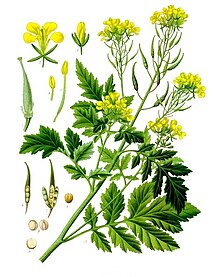White mustard
| White mustard | |
|---|---|
 |
|
| Scientific classification | |
| Kingdom: | Plantae |
| (unranked): | Angiosperms |
| (unranked): | Eudicots |
| (unranked): | Rosids |
| Order: | Brassicales |
| Family: | Brassicaceae |
| Genus: | Sinapis |
| Species: | S. alba |
| Binomial name | |
|
Sinapis alba L. |
|
| Synonyms | |
|
Brassica alba |
|
Brassica alba
Brassica hirta
White mustard (Sinapis alba) is an annual plant of the family Brassicaceae. It is sometimes also referred to as Brassica alba or B. hirta. Grown for its seeds, mustard, as fodder crop or as a green manure, it is now widespread worldwide, although it probably originated in the Mediterranean region.
White mustard is an annual, growing to 70 cm high with stalkless pinnate leaves. Similar to Sinapis arvensis.
Most common in Europe, North Africa, the Middle East and Central Asia, it can be found worldwide. It has been found as far north as Greenland, and naturalized throughout Great Britain and Ireland.
The yellow flowers of the plant produce hairy seed pods, with each pod containing roughly a half dozen seeds. These seeds are harvested just prior to the pods becoming ripe and bursting.
White mustard seeds are hard round seeds, usually around 1.0 to 1.5 mm (0.039 to 0.059 in) in diameter, with a color ranging from beige or yellow to light brown. They can be used whole for pickling or toasted for use in dishes. When ground and mixed with other ingredients, a paste or more standard condiment can be produced.
The seeds contain sinalbin, which is a thioglycoside responsible for their pungent taste. White mustard has fewer volatile oils and the flavor is considered to be milder than that produced by black mustard seeds.
In Greece, the plant's leaves can be eaten during the winter, before it blooms. Greeks call it vrouves (βρούβα) or lapsana (λαψάνα). The blooming season of this plant (February–March) is celebrated with the Mustard Festival, a series of festivities in the wine country of California (Napa and Sonoma Counties).
Mustard sauce has traditionally been prepared in the following manner:
...
Wikipedia
